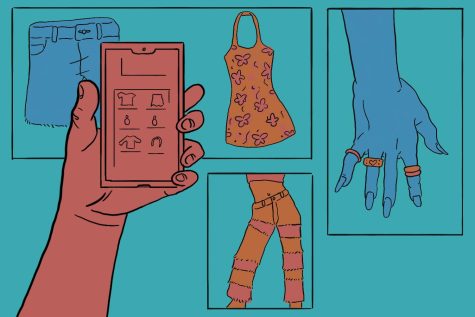Column: How 2021 taught us to be more with less
May 10, 2022

Comfortably laid up in my bed with my favorite blanket, I scroll aimlessly through my TikTok “For You” page. I notice, over time, one distinct, fuzzy, black-and-white floral handbag show up in almost every video I swipe through.
“That’s so ugly,” I first think.
Ten a.m. becomes 1:30 p.m., and I am still warped into the clock app — only now, I have seen that same bag about a gazillion times, and I start to feel a change of heart.
“Actually … that would look so cute with this one top I have … maybe paired with these boots like the one’s she’s wearing,” I convince myself. The next thing I know, I have switched apps and am on Depop and Amazon, frantically searching for a copycat of this bag I once thought was atrocious.
That “everyone has it, I gotta have it” phenomenon these days is often attributed to social media; more specifically, influencers and influencer marketing.
Melissa Gamble, an assistant professor in the Fashion Studies Department, said influencer marketing is a type of social media advertising that uses endorsements for product mentions from influencers — individuals with specific social platforms and a following that makes them look like experts in a niche.
Why is this so effective?
Because the credibility they build with that following and recommendations from them serve as a valuable form of social proof.
My time being bored at home did not help with my constant need of short bursts of serotonin from a package, and participating in various microtrends offered me just that. Gamble said microtrends differ from season to season, and with COVID-19 having kept me in my house for two years, I was able to see a multitude of fads come and go.
In fashion, a microtrend is a fad that will fall faster than its popularity grew. Take these jeans as an example — remember them? If you got them in 2020 when they ravaged Pinterest boards, chances are they’re sitting bunched up in your closet somewhere now, never to see the light of day again.
When it comes to differentiating between what is “trendy” versus “timeless,” Gamble explained the key component is that a timeless piece happens over time where it slowly becomes a classic — just think of the little black dress.
“In terms of how you identify if something is a trend, a lot of forecasters will talk about the rule of three,” Gamble said, adding that when considering factors for that rule, they could be anything from the color to the silhouette of the piece. “If you see it in three different kinds of unrelated places, … that’s something to start to pay attention to.”
In addition to mircrotrends, social media has had its fair share of influencers promoting macro trends as well — what Gamble described as a cultural shift or a larger movement. Sustainability is a prime example of a macro trend because it has been discussed in multiple industries besides just fashion and can have a larger impact on factors such as the climate and economy.
With the rise of saturated resin rings to hibiscus-print halter dresses all over social media feeds, sustainability and capsule wardrobes became just as popular. Discourse through social media consisted of both showing consumers all the latest “gotta have it” pieces, with other influencers rallying the message of mindfully participating in trends that would benefit individuals most.
At the start of quarantine, I’ll admit: I really liked following trends, and they helped me try new pieces I otherwise never would have thought to wear. But now, I feel like I think the complete opposite — following them closely can lead to a feeling of never having enough and always wanting more, which can end up being both unsustainable and expensive.
Trends come and go, and while not all of them are worth pouring our wallets into, they do serve as a means to incorporate new styles into your wardrobe and get out of your comfort zone — and even going beyond just fashion, most importantly, social media and its perfect marriage to pushing out different trend cycles has offered many groups a platform for exposure to a variety of topics.
“[Social media is] global, and so it really has diversified trends significantly. It has raised visibility for a lot of cultures and communities, and both people and trends that we would otherwise not have any exposure to,” Gamble said.
Gamble also said the impact of social media can be seen outside the fashion realm.
“I think it’s done really incredible things for the Black Lives Matter movement, the LGBTQ+ community and enabling consumers to connect with influencers or people in that community that they identify with, so there’s a really powerful impact there both in terms of trends, but also just in terms of building sort of these subcultures online,” Gamble said.
Fashion’s constant evolution through social media has made it fun, engaging and easy for those who are interested in trying new things to start somewhere — and while societal issues should not be seen as fads, the internet has offered a plethora of resources and opportunities for the most important thing in combating them: exposure.







